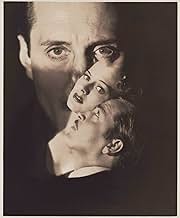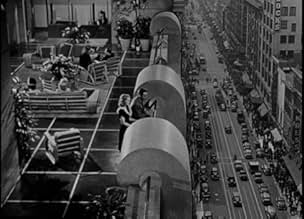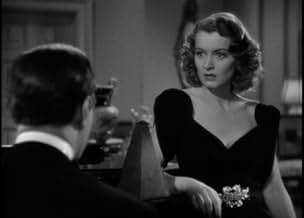Füge eine Handlung in deiner Sprache hinzuA crazed physician marries a wealthy women and, with the help of his demented assistant, murders them for their money.A crazed physician marries a wealthy women and, with the help of his demented assistant, murders them for their money.A crazed physician marries a wealthy women and, with the help of his demented assistant, murders them for their money.
Barbara Jo Allen
- Louise Watkins
- (as Barbara Allen [Vera Vague])
Bobby Barber
- Bald Man in Library
- (Nicht genannt)
William 'Billy' Benedict
- Mickey Barnes - Copy Boy
- (Nicht genannt)
George Chandler
- Elevator Operator
- (Nicht genannt)
Edward Earle
- Librarian
- (Nicht genannt)
Chuck Hamilton
- Police Officer at Train Station
- (Nicht genannt)
Sam Harris
- Passerby
- (Nicht genannt)
Harry Hayden
- Ticket Clerk
- (Nicht genannt)
Douglas Kennedy
- Hotel Clerk
- (Nicht genannt)
Settar Körmükçü
- Dr. David Profesor
- (Nicht genannt)
John Laing
- Intern
- (Nicht genannt)
Empfohlene Bewertungen
Strangely lacklustre reviews to this quite novel 1940 Noir. Insightful, knowledgeable scripting, wonderful schwartz photography from Ted Tetzlaff. A sinister Rathbone undulating between predator and smitten, with both his male accomplice and the full lips of Ellen Drew on the way to more resolute acting ahead. The opening 10 minute rainstorm introduces the maelstrom perfectly and it continues at a good pace, with a variety of well edited sequences adding to the narrative flow, the high night time shots above 5th Avenue conjured well by subtle SFX. The ubiquitous Ben Hecht had a hand in the screenplay, alongside Harold J. Green, and it shows in this robust, ballsy psycho-drama.
Basil Rathbone stars with Ellen Drew in The Mad Doctor from 1940.
Rathbone plays a psychiatrist, George Sebastien, who is a black widower, marrying women for their money and then killing them. The last time, the doctor in charge of his wife's case (Ralph Morgan) is suspicious, but Sebastien convinces his assistant (Martin Kosleck) that the old man is harmless. As usual, they pick up stakes, this time moving to New York City.
Sebastien becomes aware of a beautiful young woman, Linda Boothe (Drew) who is depressed and suicidal. He agrees to take her case.
Her boyfriend (John Howard) doesn't believe in psychiatry and wants to discredit him. As a reporter, he writes a series of negative articles.
The problem here is that Howard takes such an instant dislike to the doctor that it just comes off as jealousy. However, Sebastien does get to the reason for Linda's problems - her own father's suicide - and helps her.
Sebastien has actually fallen for Linda and believes he has been cured of his desire to kill. That apparently arose from his first wife cheating on him.
This is a very entertaining if strange film. One wonders about the relationship between Sebastien and his assistant, who is furious that Sebastien wants to marry Linda and stop killing.
Rathbone is terrific - romantic, charming, and evil. Drew is a lovely actress and ideal in her role. Martin Kosleck as the bizarre assistant is just right.
Recommended. Rathbone is always good.
Rathbone plays a psychiatrist, George Sebastien, who is a black widower, marrying women for their money and then killing them. The last time, the doctor in charge of his wife's case (Ralph Morgan) is suspicious, but Sebastien convinces his assistant (Martin Kosleck) that the old man is harmless. As usual, they pick up stakes, this time moving to New York City.
Sebastien becomes aware of a beautiful young woman, Linda Boothe (Drew) who is depressed and suicidal. He agrees to take her case.
Her boyfriend (John Howard) doesn't believe in psychiatry and wants to discredit him. As a reporter, he writes a series of negative articles.
The problem here is that Howard takes such an instant dislike to the doctor that it just comes off as jealousy. However, Sebastien does get to the reason for Linda's problems - her own father's suicide - and helps her.
Sebastien has actually fallen for Linda and believes he has been cured of his desire to kill. That apparently arose from his first wife cheating on him.
This is a very entertaining if strange film. One wonders about the relationship between Sebastien and his assistant, who is furious that Sebastien wants to marry Linda and stop killing.
Rathbone is terrific - romantic, charming, and evil. Drew is a lovely actress and ideal in her role. Martin Kosleck as the bizarre assistant is just right.
Recommended. Rathbone is always good.
"Oh, there's no such thing as sanity. At it's best a heroic and precarious little hiding place in which we try to conceal ourselves from the devils...The devils of time, space, things unknown, and the past."
Although its title suggests conventional horror, "The Mad Doctor" is a pitch black thriller with some with some truly harrowing subject matter. Basil Rathbone plays Dr. Sebastien, a Bluebeard-like psychiatrist who recently killed off his wealthy wife Ida. After arousing the suspicion of local doctor Ralph Morgan, Rathbone leaves town. He soon finds his next mark, a deeply troubled young socialite named Linda that's been suffering with suicidal ideations.
Rathbone is accompanied in his efforts by Martin Kosleck as Maurice, a sort of male secretary. After seeing these two interact, it becomes very clear that they are more than criminal accomplices. When we see Kosleck in Rathbone's home or office, he's variously arranging flowers, spritzing himself with cologne, fussing with Rathbone over a choice of tie, and languorously sketching a black cat while wearing a bathrobe. When Rathbone starts to become genuinely interested in Linda, Kosleck responds with wounded jealousy.
This is very obviously a coded gay relationship, years ahead of the one in Hitchcock's "Rope." The scenes between Rathbone and Kosleck, both superb actors, positively crackle. In one scene, Rathbone gives a bone chilling monologue describing his contempt for dead wife Ida: "These atrocious paintings. This absurd wallpaper. These pathetic antiques. They all breathe her spirit. I can almost see her now coming down those stairs with that foolish smile and the love light in her eyes. I can never forgive her the eight months spent in this cave of romance."
The danger and intensity only ratchet up from there, climaxing in a truly haunting and beautifully executed ending. This is one of Basil Rathbone's most underrated films.
Although its title suggests conventional horror, "The Mad Doctor" is a pitch black thriller with some with some truly harrowing subject matter. Basil Rathbone plays Dr. Sebastien, a Bluebeard-like psychiatrist who recently killed off his wealthy wife Ida. After arousing the suspicion of local doctor Ralph Morgan, Rathbone leaves town. He soon finds his next mark, a deeply troubled young socialite named Linda that's been suffering with suicidal ideations.
Rathbone is accompanied in his efforts by Martin Kosleck as Maurice, a sort of male secretary. After seeing these two interact, it becomes very clear that they are more than criminal accomplices. When we see Kosleck in Rathbone's home or office, he's variously arranging flowers, spritzing himself with cologne, fussing with Rathbone over a choice of tie, and languorously sketching a black cat while wearing a bathrobe. When Rathbone starts to become genuinely interested in Linda, Kosleck responds with wounded jealousy.
This is very obviously a coded gay relationship, years ahead of the one in Hitchcock's "Rope." The scenes between Rathbone and Kosleck, both superb actors, positively crackle. In one scene, Rathbone gives a bone chilling monologue describing his contempt for dead wife Ida: "These atrocious paintings. This absurd wallpaper. These pathetic antiques. They all breathe her spirit. I can almost see her now coming down those stairs with that foolish smile and the love light in her eyes. I can never forgive her the eight months spent in this cave of romance."
The danger and intensity only ratchet up from there, climaxing in a truly haunting and beautifully executed ending. This is one of Basil Rathbone's most underrated films.
Quite a few reviews here have mentioned the ' relationship ' between Basil Rathbone's character and Martin Kosleck's character as being coded homosexuals. I thoroughly endorse this as I watched this film quite by accident on YouTube and I was surprised to see just how intimate in speech and gesture this couple were. The fact that they were both killers and that women had been murdered for their rich lifestyle reminded me of other homosexual killers in both ' Rope ' and ' Compulsion. ' and how somehow they got certificates in the UK admitting children with adults to see them. In the UK the film was called ' A Date with Destiny ' and not the horror signifier of ' The Mad Doctor ' which would have called out for an H certificate for adults only. Rathbone believes he has been saved from evil by falling in love with his last prospective victim, and his male partner, quite rightly becomes as righteously cross as an abandoned ' wife ' or ' husband. ' A Queer film indeed which has not as far as I can tell by historians of Queer and Gay cinema been noticed. America has been fiercely aggressive towards positive gay endings, even to today so any representation on screen of a possible gay character or two in a partner relationship has had to follow the tropes of abandonment, death or imprisonment. For a gay audience these negatives had to be also positives simply because homosexuality was overtly or implicitly seen on the screen. I could take a swipe at a few recent examples but I will concentrate on this 1941 film. Tim Whelan directs it well in Film Noir mode, and there are outstanding shots of New York during this period. The editing excellent and the acting exceptionally good, Ellen Drew as the last potential victim is perfect, shading her role from black mood to light laughter with professional expertise. I must mention Barbara Jo Allen as a friend who has a lot of great lines, delivered to perfection. A definite Paramount Eve Arden, lightening the film whenever she is in a scene. To sum up a taut thriller with touches of horror this deserves in my opinion a ten. A vastly underrated film on all levels. One final observation: the BBFC was very reluctant to give out H certificates during WW2, so that may explain the change of the film's title.
Doctor Ralph Morgan calls at Basil Rathbone's home. His patient, Rathbone's wife, has died. Morgan is suspicious; she was recovering. He does nothing about it.
His suspicions are justified. Rathbone speaks with his manservant, Martin Kosleck, of how much he despised his rich wife and her stupid town, just like his other victims. They will return to New York, and he to his practice as a psychiatrist. There he is hired to deal with Ellen Drew, a depressed and suicidal socialite whose newspaper boyfriend, John Howard, has his suspicions. His investigations lead him to Morgan, even as Miss Drew marries Rathbone.
Rathbone offers his usual graceful performance as a man struggling with redemption. Most noteworthy of all, however, is Ellen Drew's performance as someone suicidal when we first meet her, to someone lighthearted after the ordinary pleasures of Coney Island. Alas, there is no sign of revival of her psychoses at the end, but in that era, endings had to be happy, even in a movie that focuses on Rathbone's attempts to deal with his own dark desires.
Hecht and MacArthur did uncredited work on the script, and they undoubtedly gave the producers what they asked for; neither was director Tim Whelan the man to stand up for a darker vision; he had returned to the US doing work on Korda's THE THIEF OF BAGDAD, and this was his first movie after that. It was no time to antagonize the brass at Paramount.
His suspicions are justified. Rathbone speaks with his manservant, Martin Kosleck, of how much he despised his rich wife and her stupid town, just like his other victims. They will return to New York, and he to his practice as a psychiatrist. There he is hired to deal with Ellen Drew, a depressed and suicidal socialite whose newspaper boyfriend, John Howard, has his suspicions. His investigations lead him to Morgan, even as Miss Drew marries Rathbone.
Rathbone offers his usual graceful performance as a man struggling with redemption. Most noteworthy of all, however, is Ellen Drew's performance as someone suicidal when we first meet her, to someone lighthearted after the ordinary pleasures of Coney Island. Alas, there is no sign of revival of her psychoses at the end, but in that era, endings had to be happy, even in a movie that focuses on Rathbone's attempts to deal with his own dark desires.
Hecht and MacArthur did uncredited work on the script, and they undoubtedly gave the producers what they asked for; neither was director Tim Whelan the man to stand up for a darker vision; he had returned to the US doing work on Korda's THE THIEF OF BAGDAD, and this was his first movie after that. It was no time to antagonize the brass at Paramount.
Wusstest du schon
- WissenswertesOne of over 700 Paramount Productions, filmed between 1929 and 1949, which were sold to MCA/Universal in 1958 for television distribution, and have been owned and controlled by Universal ever since; its earliest documented telecast took place in Seattle Monday 11 May 1959 on KIRO (Channel 7).
- Zitate
Maurice Gretz: You're like all the other clever ones, clever until they meet a woman, and then they suddenly become fools.
- VerbindungenReferenced in Svengoolie: Night Monster (2015)
- SoundtracksAloha 'Oe
Music by Queen Liliuokalani
Top-Auswahl
Melde dich zum Bewerten an und greife auf die Watchlist für personalisierte Empfehlungen zu.
- How long is The Mad Doctor?Powered by Alexa
Details
- Erscheinungsdatum
- Herkunftsland
- Sprache
- Auch bekannt als
- La cita fatal
- Drehorte
- Produktionsfirma
- Weitere beteiligte Unternehmen bei IMDbPro anzeigen
- Laufzeit1 Stunde 30 Minuten
- Farbe
- Seitenverhältnis
- 1.37 : 1
Zu dieser Seite beitragen
Bearbeitung vorschlagen oder fehlenden Inhalt hinzufügen




































